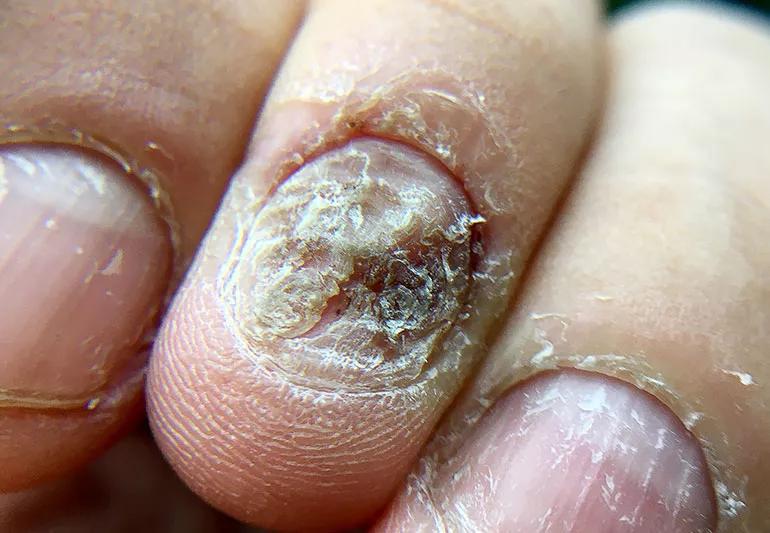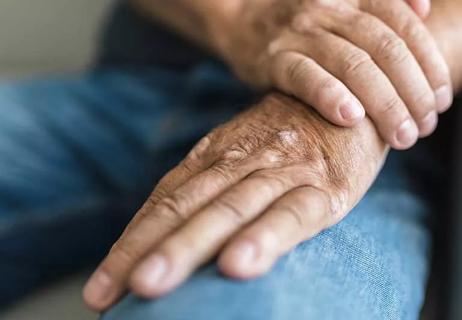Medications can reduce nail pitting, discoloration and separation

If you have psoriasis, you’re used to having red, patchy, dry and itchy skin and stiff joints. But when psoriasis starts to thicken, pit, ridge and discolor your nails, it can be hard to overlook. This is called ‘nail psoriasis.’
Advertisement
Cleveland Clinic is a non-profit academic medical center. Advertising on our site helps support our mission. We do not endorse non-Cleveland Clinic products or services. Policy
Nails can tell us a lot about our health. People often consider nail psoriasis a cosmetic issue, but “nail psoriasis is a medical disorder that can be managed with various medications and often with favorable results,” says dermatologist Amy Kassouf, MD.
This is especially important for anyone who works with their hands (surgeons, hairdressers, landscapers, etc.) or those who constantly type on a computer—the more your hands are in use, the more diminished the functionality of your psoriatic nails.
Nail psoriasis can affect your fingernails and toenails and will often manifest in these ways:
Advertisement
If your psoriasis is confined to the nail bed (below the “nail plates” you may polish), topical steroids, vitamin D3 analogue ointments and retinoid creams or gels can be effective.
But psoriasis typically goes deeper, affecting the nail matrix (below the nail plate, cuticle and nail fold skin). While topical treatments don’t penetrate the matrix of the nail, steroids can be safely injected around the nail with good efficacy.
“These injections are both safe and effective in reducing the pitting, hardening, ridging and discoloration, as well as nail separation caused by nail psoriasis,” says Dr. Kassouf.
Dermatologists usually administer injections monthly, then reassess the nails to see if further treatments or dosage changes are needed.
If you can’t tolerate or don’t respond to injections, oral medications (such as cyclosporine, acitretin, otezla and methotrexate) are occasionally used — especially when you have psoriasis-related (psoriatic) arthritis or significant skin changes.
“Beyond that, we can offer biologic drugs,” says Dr. Kassouf. “A systemic approach to treatment can be worthwhile, because many patients with skin psoriasis also have nail psoriasis, and both conditions increase the risk of psoriatic arthritis.”
More recently, a two-year study of the oral drug tofacitinib in over 1,800 patients with moderate-to-severe nail psoriasis showed significant improvement at four months that continued through one year. (One-quarter of these patients had psoriatic arthritis as well.)
Whatever treatment you receive, it’s important to avoid irritating or injuring your nails. “Irritation and injury can drive the inflammation that drives psoriasis,” explains Dr. Kassouf.
Avoid picking at your nails and manipulating them, and steer clear of harsh chemicals, such as those found in acetone and non-acetone nail polish removers.
Follow these nail-care tips at home, too:
“The progress for your nails may be slow. It can take three to six months before you see any improvement,” Dr. Kassouf says. “But most people do improve with the therapies available today.”
Advertisement
Learn more about our editorial process.
Advertisement

Choose foods high in omega-3s and antioxidants; avoid red meat and dairy

Cold or hot therapy, massage and exercise may help reduce pain and inflammation in your joints

Focus on sleep, limit alcohol and reduce your stress and anxiety to help lessen symptoms

Symptoms of nail psoriasis and how to treat it

Managing psoriatic arthritis foot pain

Does arthritis make you tired?

Physical disease can impact psychological conditions

With repeat injections over time, you may be able to slow the development of new wrinkles

Type 2 diabetes isn’t inevitable with these dietary changes

Applying a hot or cold compress can help with pain